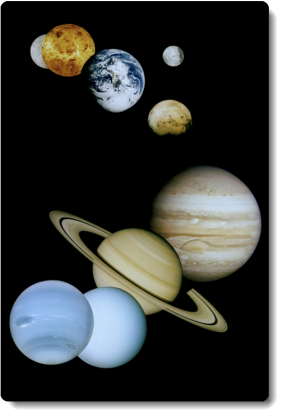Module 4: Astronomy - The Solar System
 While you may consider the place that you rest your head at night to be your home, you belong to a bigger, more complex home in the universe - the Solar System. In this module, you will explore this larger address. You will begin by exploring how scientists believe the Solar System formed from a contracting nebula some 4.6 billion years ago. Then, you will begin with the planet closest to the Sun and travel outward to the remote reaches of the Solar System, studying characteristics of each of the eight planets. In addition, you will explore dwarf and other members of the Solar System, like meteors, comets, asteroids, and trans-Neptunian objects. All of these celestial objects have their own systems of classification to help organize and structure their study.
While you may consider the place that you rest your head at night to be your home, you belong to a bigger, more complex home in the universe - the Solar System. In this module, you will explore this larger address. You will begin by exploring how scientists believe the Solar System formed from a contracting nebula some 4.6 billion years ago. Then, you will begin with the planet closest to the Sun and travel outward to the remote reaches of the Solar System, studying characteristics of each of the eight planets. In addition, you will explore dwarf and other members of the Solar System, like meteors, comets, asteroids, and trans-Neptunian objects. All of these celestial objects have their own systems of classification to help organize and structure their study.
Getting Started
![]()
![]() Before you begin your study of the Solar System in this module, take a few moments to consider the following questions: how has your perception of the Solar System changed since you were a small child? Has your idea of your place in the Solar System changed as you have grown to a young adult? It may change even more as you learn about Earth's relative size and impact in the universe.
Before you begin your study of the Solar System in this module, take a few moments to consider the following questions: how has your perception of the Solar System changed since you were a small child? Has your idea of your place in the Solar System changed as you have grown to a young adult? It may change even more as you learn about Earth's relative size and impact in the universe.
Key Vocabulary
![]()
To view the definitions for these key vocabulary terms, visit the course glossary.
| accretion | Jovian planet | regolith |
| asteroid | Kuiper belt | revolution |
| asteroid belt | lunar eclipse | rotation |
| aurora | maria | semidiurnal tide |
| chromosphere | meteor | solar eclipse |
| comet | meteorite | solar flare |
| core | meteoroid | Solar Nebula Theory |
| corona | neap tide | solar prominence |
| coronal mass injection | nebula | solar wind |
| differential rotation | nuclear fusion | solstice |
| diurnal tide | Oort cloud | spring tide |
| dwarf planet | partial eclipse | sunspot |
| equinox | photosphere | terrestrial planet |
| highlands | planetesimal | total eclipse |
| impact crater | protoplanet | Trans-Neptunian object |
| impact theory | protosun |